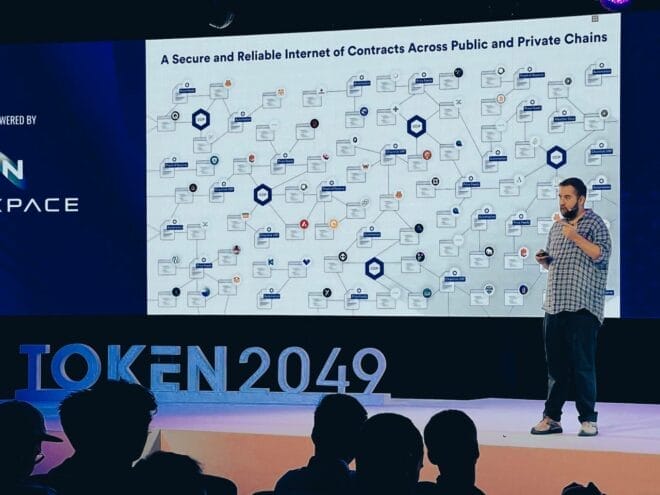Chainlink co-founder Sergey Nazarov was among global web3 visionaries sharing insights at this year’s TOKEN2049 event in Singapore. Yesterday, he delivered a presentation on key features of Chainlink’s Cross-Chain Interoperability Protocol (CCIP) that would ultimately allow DeFi and TradFi to converge into a highly secure, hyperconnected internet of contracts capable of transforming global finance.
Risk Management Network
“If you think about any other system that moves any kind of value, there’s always a risk management system,” Nazarov said, highlighting examples from the past several decades of digital payments. Until CCIP, he explained, risk management systems didn’t exist in the cross-chain world.
CCIP’s Risk Management Network is a separate decentralized oracle network, run by multiple independent node operators, that can be configured to accommodate different bridges, users, counterparties, and risk appetites.
“We’ve made a way to make thousands of bridges that also have good risk management that people can configure to meet their requirements,” Nazarov said. “And the better you are at risk management, basically the lower the cost will be at a higher speed.”
Cross-Chain Messaging
Another key feature of CCIP is the ability to facilitate cross-chain data along with digital assets. Having already enabled over $8.5 trillion in transaction value by delivering market data on-chain, Nazarov said Chainlink can now utilize its decentralized oracle networks to transmit, confirm, and validate data cross-chain.
“You can transfer a message to instruct other contracts to do things even if you don’t move a token,” he said. “This means you can control contracts through CCIP from some other place. But the really powerful thing is when you combine the token and the value with instruction.”
He illustrated how CCIP’s combination of cross-chain token movement and messaging streamlines the user experience associated with bridges that typically involve “anywhere from 6 to 15” manual steps.
“This thing is one step,” he said. “You basically say, ‘I want my token to go over there and do this thing.’ Done. And you can do that from a wallet or a chain or actually your own web2 backend.”
Updated Tokenized Real-World Assets
By facilitating cross-chain liquidity, CCIP enables the tokenization of real-world assets such as real estate, art, precious metals, and IP, allowing them to be fractionalized and used as collateral on-chain. CCIP can also automatically update on-chain assets to reflect off-chain or real-world market data.
“So you make an asset on Bank Chain A; it goes to Bank Chain B because they bought it; and then it gets put in Custodian Chain C,” Nazarov explained. “But the asset still needs to be updated with the status of the gold, or the status of the house, or the status of whatever. If you don’t update the real-world asset, it’s not so useful anymore, because it’s not connected to the real world.”
Blockchain Abstraction Layer For Banks
The world’s biggest provider of secure financial messaging services, Swift, recently announced its successful proof of concept demonstrating how more than 11,500 global banks can interact with a range of public and private blockchains through one integration with CCIP.
“What CCIP does is it creates an abstraction layer for banks to easily utilize all chains, whether they’re bank chains or public chains,” Nazarov said. “Our goal is to facilitate those transactions between those banks in their private bank chain world; then the next goal is to make sure those bank chains with trillions of dollars can connect to public chains.”
He envisions CCIP-enabled blockchain hyperconnectivity will ultimately give rise to a cryptographically guaranteed alternative financial system, telling TOKEN2049’s audience, “If you ever wondered how the global financial system ends up running on crypto, this is how.”


